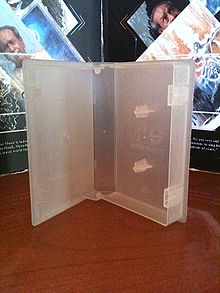Solid joint
A solid body joint is an area of a component that allows relative movement ( rotation ) between two rigid body areas through bending .
The solid joints include simple film hinges on plastic packaging as well as the solid concrete joints that are part of a supporting structure in construction .
function
The solid-state joint is not a “real” joint in the sense of a kinematic pair , but is based on the principle of elastostatics ( elasticity ). The function of a joint is achieved by an area of reduced flexural rigidity relative to two adjacent areas of higher flexural rigidity. The reduced bending stiffness is mostly generated by local cross-section reduction. A flexure joint can be compared to a conventional swivel joint, which has a limited range of rotation.
application
Solid-state joints are often used, especially in microsystem technology , because real joints, which classically consist of at least two coupled individual elements, can only be manufactured and assembled in microscopic dimensions with great difficulty and with great effort. In normal dimensions, solid body joints are an inexpensive alternative to real joints as wear parts. In classic machine and device construction, they are seldom used due to their lower long-term functional reliability, but often used in the area of particularly cost-effective products.
Restriction
A considerable disadvantage arises from the strong material fatigue when bending or continuous vibration (see fatigue test ). Due to the very different fatigue strength of materials, flexure joints cannot be realized with every material.
literature
- Nicolae Lobontiu: Compliant Mechanisms: Design of Flexure Hinges. CRC Press, Boca Raton, USA 2002, ISBN 978-0-8493-1367-7 .
- Jungnickel Uwe: Miniaturized positioning systems with several degrees of freedom based on monolithic structures . Darmstadt dissertation, Darmstadt, 2004, pp. 34-45.
